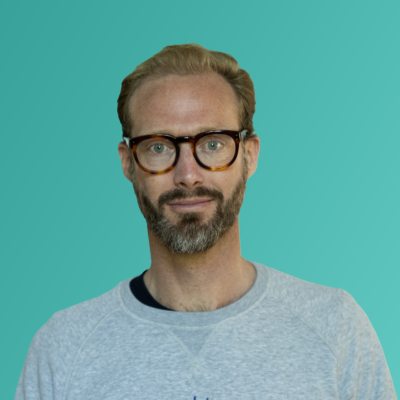Discover how our business transformation led us to create our Sustainable Innovation Model.
- For the shorter version, watch our less-than-2-min video.
- For the complete story, read on. It is a 15-min read.
- For more information about the Sustainable Innovation Model itself, click here.
Our Sustainability-Driven Transformation Journey
Initiating Our Journey
Over the past 17 years, SteepConsult by CBTW has shifted its business model. It evolved from a consulting company that placed experts on missions on an hourly basis into a consulting firm with a greater focus on achieving specific output for its clients. More recently, the leadership team initiated a turn toward a business model focused on enabling sustainable impact, rather than solely offering experts and delivering output.
However, there is often a gap between vision and field reality — a transformation gap. When this new direction was first shared within the company, questions arose:
- “Sustainable? What do you exactly mean?”
- “Impact? What kind?”
- “Is our organization fit for impact?”
- “Which consequences will this new direction have on our strategy, priorities, decisions, organization, ways of working, and our people?”
Given our vast ambition and our current output-focused business model, we had to transform deeply. We had to initiate, design, and implement our own sustainability-driven transformation*, which is an evolution rather than a shock or a shift in our case. By doing so, we could later guide our clients through the same process with confidence.
What do we mean by “transformation”?We adopt the definition of transformation by Christian Rangen, founder of Strategy Tools, as “a significant, lasting and non-reversible change to the company’s value creation logic”.
He also distinguishes three types of transformation:
• “Shocks” are triggered by outside events or outside pressures that force the company to transform, or at least attempt to transform. Case: Nokia.
• “Shifts” are sudden strategic move that carries massive and abrupt changes to the business models and underlying value creation logic. Case: Adobe.
• “Evolutions” are long-term (potentially 10+ years), planned and well-executed gradual change in resource allocation and business areas. Case: Microsoft.Learn more about it on the Three types of Transformation here or dive deep into the matter with their Build the Transformational Company Report.
Learning from Other Companies
We began with a few realizations, drawn from observing companies we find innovative and impactful such as Tesla, IDEO, SpaceX, BYD, Patagonia, Decathlon, and more. We found out that a successful and impact-making company:
- Has a strong vision.
- Has strong buy-in from its employees for that vision.
- Can translate the vision into an operating plan that resonates with people, motivates them, and accelerates value creation.
- Offers products and services that meet customer expectations and aspirations.
It may seem simple, but it is often quite complex to implement. As we started with ourselves, the process became more concrete:
- What was our vision?
- What would be our capacity to translate it into something our consultants and staff (we call each other associates) could align with and operate?
- How would we satisfy our clients? Etc
What do we mean by “associates”?We call our employees “associates” because each of us is invited to associate our ideas and effort to co-create value within our organization and at our clients’.
Engaging Our Associates
We looked ahead and brought together an interdisciplinary team from every area of our organization. Together, we tapped into our collective intelligence to shape our vision and mission. We then shared this unified outcome with all our associates, over 130 in total, through multiple Town Halls and our newsletter.
During this exercise, we realized the importance of retaining our existing values of collaboration and human-centricity (considering our associates, our clients’ employees, and their customers) while adding one more: sustainability – the value that drives our impact on our society and the planet.
A New Mission and Vision
Today, the mission of SteepConsult by CBTW has evolved into harnessing an organization’s potential for sustainable impact. We have all contributed to a negative impact on the planet, and our aspiration is now clear: to generate a positive impact. This impact must benefit people – including our employees, our clients’ employees, our clients’ customers, and society – as well as the planet we live on. All of this, while generating profits that can be reinvested meaningfully into our mission.
In our new vision, we at SteepConsult by CBTW are all caring and innovative advisors, dedicated to creating a positive impact for people, the planet, and responsible profit.
This new mission and vision clarified and strengthened our desire to create a positive impact for the world, pushing us to accelerate our transformation and set more ambitious goals.
A New Business Strategy
Three years ago, we embarked on a sustainability-driven transformation program addressing the three ESG (Environmental, Social, and Governance) pillars. We allocate significant resources to the Corporate Social Responsibility (CSR) department and the program is gaining momentum. We collaborate with associations and NGOs on the Sustainable Development Goals targeting Good Health & Well-Being and Quality Education. We are also making progress in environmental aspects through carbon footprint assessment and decarbonization projects.
And for a while, CSR was our only window toward having a positive impact on the world. But our mission and vision opened new, larger, bolder avenues for us. Sustainability is no longer the responsibility of a few people in the company. It has become an integral part of our business, and we ensure that our business strategy now reflects it.
Not only has this strategy reinforced our CSR ambition and program, but for the first time, SteepConsult by CBTW was mandated to develop new solutions in parallel to our core business of selling expert time and output to our clients. This mandate consists of:
- Growing our client opportunities to pivot our core business toward advising sustainability-driven transformations.
- Exploring new uncharted territories in the specialized fields of human and environmental sustainability consulting, by leveraging partnerships outside the walls of our organization. As these explorative opportunities show potential, we will further turn them into growth areas.
The desired outcome of this strategy is a significant change in our positioning within the management consulting industry and a total reshaping of our sources of revenues and margins in the mid- to long-term future.
A New Operating Model
To support the ambitions captured in our Core-Growth-Explore framework, we adapted our expert-based operating model. Instead of fields of consultant expertise, we now organize SteepConsult by CBTW into 5 domains of solutions – encompassing both expertise and products: Governance, Agility, Innovation Strategy, Data Strategy and (soon) Employee Engagement. The latter was directly born from our strategic choice made to explore human sustainability consulting, with the objective to improve the well-being of a large portion of the world population: employees.
Together, these four domains provide our consultants and clients with comprehensive and integrated solutions for driving the change that leads to more sustainable innovations and impact. This new domain-centric model builds upon and co-exists with the Collaborative Operating Model of CBTW that fosters company-wide innovation by leveraging internal communities of practice.
Adhesion of our Associates.
This new operating model is also more people-centric, as it establishes a direct bridge between our consultants and the new domains. The domain teams can take a more active role in guiding the consultants in their mission and the development of their expertise and career.
This model shift delivered an exceptional result in 2022 with an Employee Net Promoter Score* (ENPS) of 51 for SteepConsult by CBTW. A score above 20 is typically considered excellent, reflecting a strong positive sentiment among employees. Therefore, this result is quite unique in our management consulting industry and rewards our efforts in co-creation, transparency, and impact-driven operations.
What do we mean by “ENPS”?The ENPS is based on measuring how likely employees would be to recommend their company to a friend and categorizes employees into detractors, neutral individuals, and promoters. The Employee Net Promoter Score is obtained by subtracting the detractor scores from the promoter scores, an then dividing by total respondents.
– An ENPS of 0 means there is an equal number of detractors and promoters, indicating a neutral sentiment.
– Scores above 0 suggest that you have more promoters than detractors, which is generally seen as positive.
– A score above 10 is often considered favorable and indicates a higher level of employee satisfaction and loyalty.
– A score above 20 is typically seen as excellent, reflecting a strong positive sentiment among employees.
Challenges & next Steps ahead
As we make progress in our internal sustainability-driven transformation, we are faced with several key challenges ahead.
Operations Optimization
In the midst of transformations, specific areas of the organization often encounter greater complexity and require more effort to enact change. In our case, it’s the newly established domain teams that bear the most significant responsibility of shaping the future of SteepConsult by CBTW, with high expectations resting on their shoulders.
One immediate challenge they face is the friction generated by the new operating model. We are transitioning from a model primarily focused on selling hourly expertise and output to one centered around growth solutions organized into domains. Consequently, the domain teams must juggle and continue to support core business activities while simultaneously driving the development of growth areas.
Operating Model Implementation
To facilitate this transitional phase, the implementation of the operating model needs to be executed with the right level of operational granularity and speed. This also requires prior optimization of core business operations to relieve the domain teams from core-related activities as much as possible, enabling them to concentrate on solution development.
Impact on our Innovation culture
This evolution will enable the domain teams to redirect their resources toward the key purpose and primary focus of their mission: innovation. This includes the creation of novel consulting solutions, identifying the right consultants for deploying these solutions with our clients, and fostering an innovative culture throughout the company.
The Sustainable Innovation Model
A Model that Synthesizes the Insights Drawn from Our Transformation Journey
The transformation we are going through at SteepConsult by CBTW provided us with invaluable insights to become better advisors – guiding our clients from potential to sustainable impact. This experience informed the creation of our simple but powerful model for sustainability-driven transformations that combine human-centered and planet-positive impact with useful profitability and exceptional employee satisfaction.

A Model with 6 Sustainability-Driven Transformation Levers
Our model revolves around six transformation levers, which should ideally be activated in the order shown below. They help generate internal traction and lay the foundations of a comprehensive transformation roadmap.
- Company Vision & Strategy: Placed in the middle of the model, this lever is the guiding star throughout the sustainability-driven transformation journey. It must clearly incorporate sustainability as a core ambition, hence the mention of people, planet, and profit at the periphery of this circle. It’s worth noting that this model can be applied at various organizational, such as business units, regions, or departments. The Core-Growth-Explore framework, mentioned in our journey, can help define a robust map of the transformation initiatives to come. Our Innovation Strategy domain team can share its expertise in this regard.
- Employee Engagement: We believe that the transformation should be as participatory as possible, favoring transversal and bottom-up initiatives and momentum whenever feasible. Therefore, it is crucial to involve and empower employees by helping them take ownership of the vision & strategy. We recommend investing in communication, facilitation, change management resources, as well as employee engagement advisory.
- Operations Optimization: To ensure that a company can afford the transformation and take calculated innovation risks, it is important to run its core business as efficiently as possible. An often-overlooked aspect of transformation is the optimization of existing operations, especially in the departments that will be the most impacted. While financial investments and new resources can be allocated to facilitate the process, inefficient core business processes and operations may act as background noise, slowing down and diverting change efforts. Our Governance domain teams and our Business Analysis experts can offer fresh perspectives into current business operations.
- Operating Model Evolution: It is essential to translate the vision & strategy into the company’s organization, processes, governance, and operations, from top leadership to the shop floor. They must align with the vision’s objectives and ensure that every part of the organization efficiently plays its role in making it a reality. It is advised to detail the practical aspects of the operating model to ensure a smooth transition and change in ways of working. Our Governance domain team can support the design of such model.
- Innovation: Thanks to levers 3 and 4, resources are freed and effectively channeled to develop impactful innovations, both internally and through external partnerships. Not all innovations need to happen in-house, especially when exploring entirely new opportunity areas that are distinct from the core business. Partnering with other companies, co-investing in start-ups, or co-developing accelerator programs can be strategic options. Establishing an innovation management structure and process is part of the transformation roadmap to oversee and support the innovation effort and portfolio. Our Innovation Strategy domain team can offer expert advice and support on this matter.
- Company Culture: We ensure to close the loop by embedding the participatory sustainable innovation mindset in the company’s culture. The employees must see and feel that the company fully embraces the new vision and strategy. This can be achieved through leadership teams leading by example, conducting systematic sustainability assessments of company suppliers and partners, or implementing incentive programs for sustainability-driven initiatives and innovation. Our Employee Engagement domain teams and Change Management experts can give valuable guidance on these topics.
A Model that Fuels Sustainable Innovation
This model shows us which levers to use to transform companies for sustainable impact. Yet, its name does not mention “transformation” but “innovation”. Why is it so? This is because innovation is the spirit and dynamic that we seek to ignite and maintain across any company that is intentional about creating sustainable impact. Sustainable innovation is the purpose of sustainability-driven transformation.
Why emphasize innovation?
A company’s current core business started as an idea that was first explored, then developed, and eventually established as central. So, considering innovation in the broad sense, ranging from continuous improvement to disruptive inventions, it enables companies to continuously adapt to changing environments and reinvent themselves to create sustainable value and impact. Thus, we believe that innovation is the indispensable engine for positive change in the modern world, and each employee should be empowered and rewarded to contribute to this collective effort.
A Model We are Ready to Use to Guide Other Organizations
With our firsthand experience and knowledge gained from our own sustainability-driven transformation, we can now expand outward and assist our clients in designing engaging and impactful organizations.
If you are interested in learning more about this model or how it can help you create more impact with better employee satisfaction, feel free to contact us:
Our authors

Managing Director
Few words about Tristan
Tristan joined CBTW in 2012 in the Technology service line. When CBTW acquired Steep in 2017 he became managing partner of Steep by CBTW. By reaching an ENPS of 51 in 2022 and growing activities from 30 to 100 coworkers, Tristan strongly believes that co-creating an inspiring vision and reaching results is a possible achievement for all kind of companies.

Employee Engagement Domain Expert
Few words about Uta
Inherently idealist and spiritual, Uta draws upon her experience in communication, change management, strategy, and design thinking to bridge the corporate and spiritual worlds, frequently misperceived as incompatible. She is currently establishing a new Employee Engagement domain at Steep by CBTW, with the goal of shaping the organizations of the future that will enable people to become and express their most vital selves through work.


